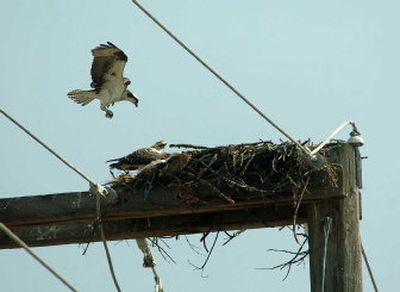Osprey entanglement

Strips of bright orange and blue twine are commonly spotted woven among the branches and bark that make up osprey nests.
Biologists say these lengths of rope entangle talons, suffocate chicks and transform nests from safe havens to traps. This is just what happened recently to an osprey family near Cheney.
In late July, scientists with the U.S. Fish and Wildlife Service received a tip that an osprey was hanging dead from a nest and another bird inside the nest was not moving. When the nest was checked out – with a helpful boost from an Inland Power and Light utility truck – three dead ospreys were discovered.
Kathleen Fulmer, a U.S. Fish and Wildlife Service biologist at the agency’s Spokane office, said the adult and two chicks became entangled in baling twine. Another adult and one chick survived. An Inland lineman removed the remaining twine from the nest.
“This happens everywhere,” Fulmer said. “It’s totally common.”
For reasons scientists don’t yet understand, ospreys are attracted to the plastic twine, which is used to bind bales of hay. Scraps of the twine are commonly found on farm fields and along roadsides.
Other raptors, such as owls and eagles, seem to ignore the twine.
Fulmer said she doesn’t think farmers should stop using the rope, but she hopes that by raising awareness of the problem, people will be encouraged to pick up any scraps of twine they see.
Discarded fishing line also is a culprit in many osprey deaths, Fulmer added.
Fulmer compared the situation to the plastic rings used to package six-pack cans of beverages. In the 1980s, after images were publicized showing seabirds and other animals entangled in the plastic rings, many people began cutting the packaging to ensure it didn’t strangle wildlife someday.
“We did it with that kind of trash. Maybe we can inform people so they think about ospreys and twine,” Fulmer said.
Fulmer said it’s not known how long the Cheney birds were trapped, but it likely was days. The surviving adult likely focused her energy on keeping the single chick alive, Fulmer said.
Osprey chicks cannot fly out of the nest for a cooling drink or to rest in the shade. They must rely on the shade provided by the wings of parents. That means the adult used her wings to shade the one chick while the other two slowly succumbed to heat and dehydration, Fulmer said. When the ospreys were cut down from the nest, their bodies were emaciated and breasts sunken.
The birds feed almost exclusively on fish and typically nest in tall trees, on power poles or on nesting platforms near water. Although osprey populations plummeted during the 1960s because of widespread use of the pesticide DDT, the birds have made a comeback, especially along coastal areas and in the Inland Northwest, where there’s an abundance of shallow lakes.
In the Lake Coeur d’Alene drainage, there are thought to be at least 100 nesting pairs, said Wayne Melquist, an osprey expert and research associate professor at the University of Idaho. Melquist also works with Raptor Chapter, a nonprofit rescue group based in St. Maries.
Ospreys are not threatened with extinction, but they are protected by federal laws.
Baling twine or fishing line is responsible for osprey deaths every year in the region, Melquist said. “We’ve seen the baling-twine issue for years and years and years. People just need to be extremely careful with monofilament line and baling twine. Just don’t let that lay around because it’s death for osprey.”
There’s no national database tracking osprey-twine entanglements, but the Spokane office of the Fish and Wildlife Service is notified of at least one or two incidents each year, said agency biologist Bob Newman.
“These are just the ones we get called on. I don’t know how many others there are,” Newman said.
The Fish and Wildlife Service often works with electrical utility companies to free entangled ospreys. Utility companies have erected dozens of nesting platforms across the Inland Northwest in hopes of providing the birds with an attractive alternative to nesting atop power poles.
Last year, an osprey was found hanging upside down from its nest in an industrial area of Spokane. The bird was severely dehydrated and barely alive when it was rescued. Despite a veterinarian’s efforts, the bird died a day later.
There was a happier ending for an entangled osprey that made its home near the Spokane River in Millwood. The young raptor’s parents had flown south for the year when its talon became ensnared in a loop of twine, Newman said. The bird already had lost one of its four talons to twine and ended up losing a second.
“That nest was almost totally orange” with twine, Newman said. “The twine was so tight around the leg you could see skin bulged up around both sides.”
The twine was cut out of the nest and the two-taloned osprey was released near Liberty Lake. The bird flew away, but its fate is unknown. “It’s going to be hard for him to perch in a tree, let alone catch fish,” Newman said.